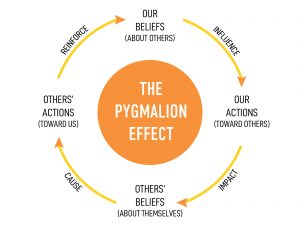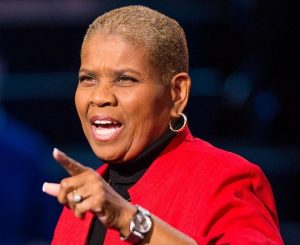Our expectations lead to creating the reality
In schools, we talk about having high expectations of our students, but how often have we reflected on our actual expectations by comparing our thoughts, words and actions? These three factors are not always aligned as they are influenced by our emotions, beliefs, relationships, and past experiences.
Think about ‘that’ student in a school whose name comes up often in staffroom conversations resulting from behaviour challenges they present. For example: “Yes Kim hurt that child.” “Kim will just destroy everything.” “I won’t be surprised if Kim is the culprit behind that incident.”
When a staff member associates with Kim and has this expectation, they will continue to think that Kim will misbehave, and then Kim actualises the expectation. To reinforce Kim’s behaviour even more, parents and peers may also have the same expectation, and the pattern of behaviour challenges continue.
Our brains are primed for survival, so understandably when a pattern of challenging behaviour has presented itself, our expectations confirm this pattern to protect ourselves from being vulnerable when confronted with the next incident. We do this to prevent more pain. We may make the situation about us, and in doing so lose sight of the child, the reasons why they are acting this way, and finding solutions to support them to break the negative cycle of behaviour.
This situation can also become far worse. Kim, in this example, can also end up as the school ‘villain’ whose identity has been shaped by many other peoples’ expectations. This can lead to a heightened superiority status where the child thrives on believing they have power and control over others (their motivation), making it even more difficult to shift this pattern of behaviour.
This all relates to both ‘Expectancy Theory’ and the ‘Pygmalion Effect’. Expectancy Theory recognises the relationships between expectations, motivation and desired outcomes. It is consistent with the notion that what we focus on expands. It has positive and negative effects depending on what the expectation is. For a child that displays challenging behaviours, there may be no motivation to improve their behaviour when the expectation is that they won’t improve.
If a child is expected to display appropriate behaviours, they are motivated to display these behaviours. Their reward may be acceptance, belonging and/or feeling positive about themselves.
The ‘Pygmalion Effect’ (see Figure 3) also supports the notion that our beliefs lead to expectations that shape our actions towards a student (Boser et al 2014). This then
determines student outcomes whether it is an achievement in their academic results or applied to their behaviour. If we change our beliefs, this creates a new expectation which
results in a different set of actions that over time can change the outcome.
Figure 3: The Pygmalion Effect
It is also important to understand that for some children, challenging behaviour is not associated with expectations but instead a specific diagnosis such as Pathological
Demand Avoidance (extremely high anxiety present in some children with ASD), that students find difficult to understand and control. This highlights the need to ensure we discover ‘why’ the child is behaving in this way. Is it our beliefs and expectations, something else we need to understand and work with, or even a combination of factors?
Research suggests that “Schools tend to be concerned with preventing or stopping the behaviour, rather than working with the underlying emotions that often generate it” (Weare and Gray 2003). This is the difference between managing the behaviour and transforming the behaviour. If we support the student to transform the behaviour by understanding and working with the cause(s), we have a far better chance of shifting the behaviour. Although the student is responsible for their behaviour, our expectations may be an important factor and another ‘challenge’ associated with the behaviour that we can change.
There are many strategies and processes we can use to support students displaying behaviours that are challenging. Here are some strategies you can consider to support
students in your school with challenges related to renewing expectations:
Change your lens (the way you see the behaviour and your beliefs)
Make every day a new day and fresh start. It is vital students know that the past does not equal the present or the future. When a new school day begins (or even straight after the challenging event), so does a new opportunity for improvement. As soon as they walk into the classroom ensure you make contact with them and let them know you believe they will have a great day and a fresh start. Look for positives in their behaviour e.g. a smile, and acknowledge acceptable actions, effort and communication no matter
how small. Remove the ‘challenge’ and replace it with an ‘opportunity’ to support the student if difficult behaviour presents itself. Have the success lenses on and see what
they can do.
Focus on the child and separate yourself from their behaviour
When a student presents with a challenging behaviour, think about the student and empathise with what they may be experiencing that has caused this behaviour. Yes, it may be difficult if they have hurt someone, but remember, this action is the result of something far deeper that needs to be addressed. Take the focus away from you and stay
calm. It is about understanding why this is happening, and supporting the student and others that are possibly affected and providing ongoing support to enable them to change the behaviour.
Assess the student holistically and understand ‘why’ this is happening
We need to go beyond academic skills and data to realise what is happening and why. Consider all factors holistically to see the bigger picture. For example, you can use a S.P.I.C.E.® Map to assess what is happening Socially, Physically, Intellectually, Culturally and Emotionally. Holistically mapping a student’s beliefs, behaviours, relationships and actions, allows you to identify triggers and recognise patterns that lead to the cause of the behaviour. Also reflect on your own behaviours and beliefs that have impacted on the
student when you complete a holistic assessment to give you opportunities to change your beliefs, expectations and actions as well. You then have the opportunity to provide
a support plan and sustainable strategies that will assist the student to transform their behaviour. This plan must be communicated to all staff so that the student experiences a
consistent approach.
Develop a growth focused school culture
Use growth focused language and feedback that shows complete positive regard for all individuals especially students that are displaying challenging behaviours as a whole school approach. This includes finding ways for the student with challenging behaviours to discover positive actions they have shown. If you measure their growth, this allows them to see the progress they are making and identify the factors that led to the growth.
Use the three Rs of Language
The way you use language to ensure the student displays acceptable behaviours is highly important. The three Rs of language is an effective approach for you to use that allows
you to focus on positive behaviours and expectations. It consists of:
- Reinforcing language: Tell them specifically what they did well/right and name it so they understand exactly what it is.
- Reminding language: Prompts them to remember what they should be doing. Using visual instructions helps them to know what to do. This can also be used to remind them of what they have completed and asking them what they need to do next.
- Redirecting language: Tell them exactly what they need to do especially when a trigger begins, to redirect the behaviour.
Be their ‘champion’
Dr. Rita Pierson’s famous TED Talk is an inspiration to all educators. It reminds us of the power we have in a child’s life to shift the cycle of negativity in their lives and allow them
to know they matter and can succeed. Each day we should be aiming to be that champion. It takes one champion to allow a child to realise they can succeed. Imagine if there were even more? What can you do to be that champion? Observe a classroom teacher who’s had success with a student displaying challenging behaviours. Notice how they interact with the student and you’ll find the qualities of a ‘champion’. Consider the language they use, their belief in the student, their relationship with the student, and the
expectations they set. Ask the student for feedback. Use this information to reflect on what you do, and what you need to change to be that champion.
Written by Georgina Pazzi
Specialist Education and Wellbeing Consultant
“How powerful would our world be if we had kids not afraid to take risks, who were not afraid to think, and who had a champion. Every child deserves a champion; an adult who will never give up on them. Who understands
the power of connection and insists that they become the best that they can possibly be.
Is this job tough? You bet-cha.
But it is not impossible. We can do this. We’re educators. We’re born to make a difference.”
Dr. Rita Pierson



